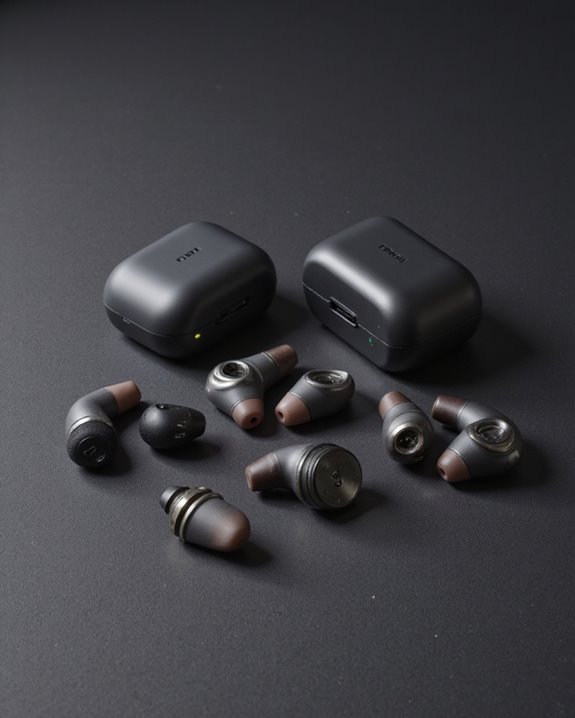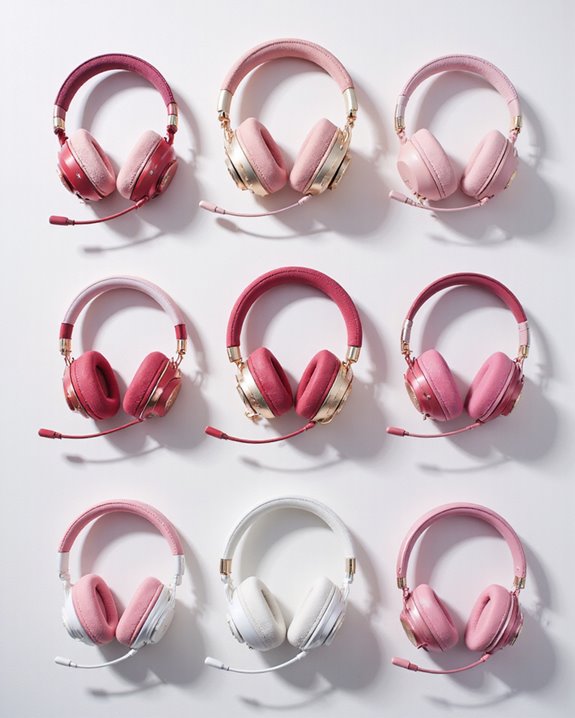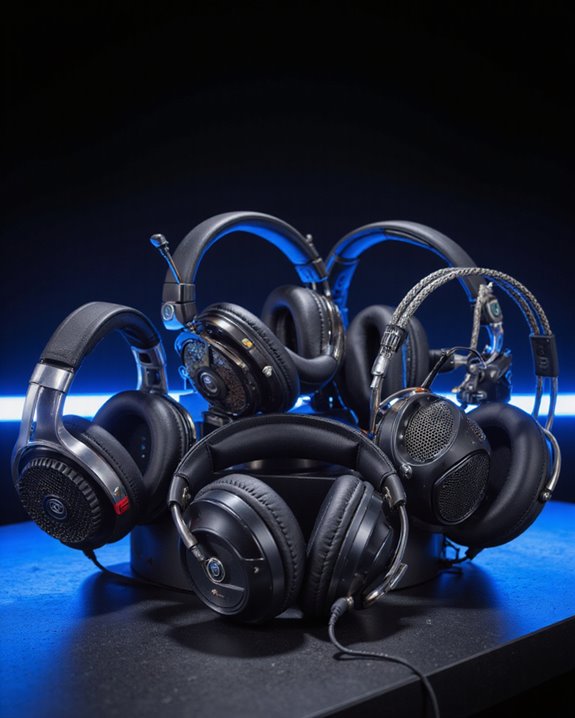As an Amazon Associate, we earn from qualifying purchases. Some links may be affiliate links at no extra cost to you. Although our opinions are based on curated research, we haven't used these products. Articles generated with AI.
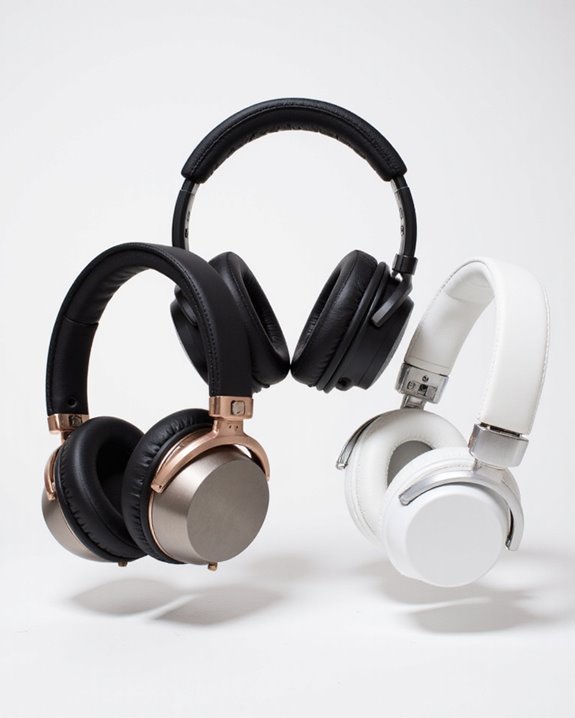
The 3 Best On-Ear Headphones of 2025, According to Audio Experts
For superior on-ear audio in 2025, you’ll find three standout options. The JVC Flats deliver balanced sound through 30mm Neodymium drivers with a lightweight 66g design, while Skullcandy’s Riff 2 offers impressive 34-hour battery life and 40mm drivers for crisp audio reproduction. The Bluetooth V5.3 Earpiece features advanced noise-canceling and a versatile charging case. Each model excels in distinct areas, from sound quality to comfort, letting you discover which features best match your needs.
Key Takeaways
- Skullcandy Riff 2 leads with 40mm drivers, Supreme Sound technology, and impressive 34-hour battery life with Rapid Charge feature.
- JVC Flats delivers excellent value through 30mm Neodymium drivers, balanced 12-24,000Hz frequency response, and lightweight design.
- Bluetooth V5.3 earpiece offers advanced noise-canceling technology and versatile connectivity options for modern audio needs.
- Both JVC Flats and Skullcandy Riff 2 maintain strong 4.4-star user ratings from over 9,500 verified customers.
- Skullcandy Riff 2’s Multipoint Pairing and built-in Tile tracking make it a standout choice for tech-savvy users.
JVC Flats On-Ear Wired Headphones with Foldable Design
JVC Flats On-Ear Wired Headphones - Flat Foldable Design - 30mm Driver for Powerful Sound - Soft...
- CONVENIENT PORTABILITY: Enjoy the convenience of a flat foldable design, making these headphones your perfect travel companion; compact enough to easily slip into any...
- EXCEPTIONAL AUDIO CLARITY: Immerse yourself in powerful sound with 1.18” (30mm) Neodymium driver units, delivering dynamic bass and crisp highs for a truly captivating...
- COMFORT FOR EXTENDED USE: Soft earpads provide superior sound isolation and a comfortable fit, allowing you to enjoy prolonged listening sessions without discomfort.
The JVC Flats On-Ear Wired Headphones are an ideal choice for budget-conscious listeners who don’t want to sacrifice sound quality for affordability. With their 30mm Neodymium drivers delivering dynamic bass and crisp highs across a 12-24,000Hz frequency range, you’ll enjoy clear, balanced audio perfect for daily use.
These lightweight headphones weigh just 66 grams and feature a foldable steel design that slips easily into bags. You’ll appreciate the comfortable soft ear-pads during extended listening sessions, while the 1.2m retractable cable connects to all your devices through a standard 3.5mm plug. Their 4.4-star rating from over 9,700 users confirms their reputation for durability and consistent performance.
Best For: Budget-conscious users, students, and commuters seeking lightweight, portable headphones with good sound quality and comfort for everyday use.
Pros:
- Excellent value with balanced sound quality and strong bass response
- Lightweight, foldable design makes them highly portable
- Comfortable soft ear-pads suitable for extended listening sessions
Cons:
- Wired-only design may be limiting for some users
- Basic features with no advanced controls or Bluetooth connectivity
- May not satisfy audiophiles looking for premium sound quality
Skullcandy Riff 2 Wireless Headphones (34Hr Battery)
Sale
Skullcandy Riff 2 Wireless On-Ear Bluetooth Headphones, Up to 34 Hrs Battery, Foldable Lightweight...
- Supreme Sound - The headphones are designed with latest sound technology, delivering crisp, clear audio that brings your music to life. Plus, use the app to tweak your...
- No Interruption Battery - With 34 hours of battery, you’ll never need to plug in mid-game again. If you do run low, our Rapid Charge feature gives you an extra 4 hours...
- Never lost with Tile - With Tile tech, Skullcandy makes it super easy to track down either headphones and keep your gadgets safe. Download the Tile app and follow the...
Students, athletes, and commuters seeking exceptional value will find their match in Skullcandy’s Riff 2 Wireless Headphones. With a 34-hour battery life and Supreme Sound technology, you’ll enjoy crisp audio optimized through customizable EQ modes in the companion app.
You’ll appreciate practical features like Rapid Charge, which delivers 4 hours of playback from just a 10-minute charge, and Multipoint Pairing that connects two devices simultaneously. The built-in Tile tracking prevents loss, while the lightweight 153-gram design provides comfort during extended wear.
At this price point, you’re getting premium features like Bluetooth 5.2, 40mm drivers, and sound isolation – though the plastic construction requires careful handling for longevity. The 4.4/5 rating from over 9,500 users confirms its reliable performance.
Best For: Budget-conscious students, athletes, and commuters seeking wireless headphones with premium features like long battery life, quick charging, and device tracking capabilities.
Pros:
- Impressive 34-hour battery life with quick 10-minute Rapid Charge feature
- Multipoint Pairing allows simultaneous connection to two devices and includes Tile tracking
- Comfortable lightweight design (153g) with customizable EQ modes through companion app
Cons:
- Plastic construction may affect long-term durability
- No water resistance rating for workout protection
- Included aux cable reported to be relatively short
Bluetooth V5.3 Wireless Earpiece with Charging Case
Sale
COTOE Bluetooth Headset V5.3, Wireless Earpiece with 500mAh Charging Case Hand-Free Headphones Noise...
- LED DIGITAL DISPLAY & 120H LONG STANDBY TIME : The G7 Wireless Bluetooth Headset comes with a smart LED display that shows the charging status of the earphones and the...
- NOISE COOLING HEADSET WITH MIC : UPGRADE G7 WIRELESS HEADSET with noise cancellation microphone that eliminates up to 99.98% of ambient noise, whether you are in a busy...
- MUTE DESIGN : COTOE Bluetooth earpiece features a mute button for privacy to meet your need for simpler muting during cell phone call. (ONLY ALLOW TO MUTE DURING CALL ON...
Modern professionals seeking extended battery life and crystal-clear calls will find their match in this Bluetooth V5.3 wireless earpiece. The 500mAh charging case delivers an impressive 120 hours of standby time and 12 hours of continuous music playback, while the LED display keeps you informed of charging status.
The earpiece’s noise-canceling microphone eliminates 99.98% of ambient noise, ensuring HD sound quality and pristine calls. You’ll appreciate the ergonomic design featuring a 45° rotatable in-ear fit, 360° adjustable ear hook, and 180° mic handle. With three ear tip sizes included, you can customize your fit for all-day comfort.
Controls are intuitive, offering mute functionality, hands-free calling, and Siri voice activation. The device pairs seamlessly with iOS and Android devices, computers, and any Bluetooth-enabled equipment.
Best For: Business professionals and remote workers who need extended battery life, clear call quality, and comfortable all-day wear for frequent communication.
Pros:
- Exceptional battery life with 120 hours standby time and 12 hours playback
- Advanced noise-canceling technology eliminates 99.98% of ambient noise
- Highly adjustable design with multiple rotation points and size options for custom fit
Cons:
- Higher price point compared to basic Bluetooth earpieces
- Single earpiece design may not be ideal for music enthusiasts
- LED display on charging case may drain battery slightly faster
Factors to Consider When Choosing On-Ear Headphones
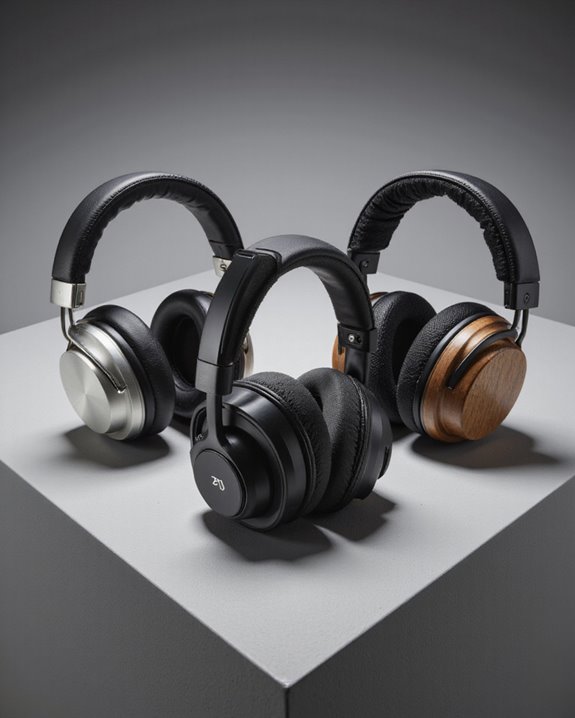
When you’re investing in on-ear headphones, you’ll need to evaluate several critical factors that directly impact your listening experience. You should start by evaluating sound quality specifications like frequency response and driver size, while also considering practical elements such as comfort features, battery runtime, and whether wireless convenience outweighs the consistent audio quality of wired connections. The headphones’ construction materials and overall build quality will determine their longevity, so it’s worth examining the durability of components like the headband, ear cushions, and any folding mechanisms.
Sound Quality and Range
The sound quality and range of on-ear headphones represent critical factors that’ll shape your listening experience. When evaluating options, you’ll want to focus on frequency response, which typically spans from 20 Hz to 20,000 Hz, covering both deep bass and crisp treble notes.
Driver size matters greatly in your headphones’ performance. Look for models featuring 30mm to 40mm drivers, as these dimensions provide robust bass response and clear audio reproduction. Larger drivers move more air, resulting in fuller, richer sound.
For ideal listening clarity, consider headphones with strong noise isolation capabilities. The best models can block up to 99% of ambient noise, while neodymium drivers deliver powerful, balanced output across all frequencies. You’ll also want to check the dynamic range specifications, which indicate how well the headphones handle volume variations without distortion.
Comfort and Fit Level
Outstanding sound quality means little if your headphones aren’t comfortable during extended listening sessions. When evaluating comfort and fit, you’ll want to focus on several key features that enhance long-term wearability.
First, look for adjustable headbands that can customize to your head size while distributing weight evenly. The best models weigh under 200 grams, preventing neck strain during marathon listening sessions. Soft, foam-padded ear cups are essential for reducing pressure points around your ears.
Consider models with ergonomic features like swivel mechanisms or flexible hooks that adapt to different ear shapes. You’ll also want multiple ear pad sizing options to guarantee a proper seal – this isn’t just about comfort, but also helps maintain ideal sound isolation. These comfort features work together to provide fatigue-free listening experiences.
Battery Life Duration
Battery life serves as a key factor in selecting wireless on-ear headphones, with modern models offering anywhere from 10 to 40 hours of continuous playback. You’ll want to evaluate your daily usage patterns when evaluating battery specifications, as features like noise cancellation can greatly impact longevity.
For frequent travelers or commuters, it’s worth looking at models with rapid charging capabilities. A quick 10-minute charge can provide up to 4 hours of playback time, ensuring you’re never without music for long. Don’t forget to check standby times, which can extend up to 120 hours.
When comparing battery specs, factor in your typical listening volume and feature usage. If you’re planning to use noise cancellation regularly or maintain constant Bluetooth connections, expect shorter battery duration than advertised maximums.
Wireless Vs Wired Options
When choosing between wireless and wired on-ear headphones, you’ll need to weigh several key factors that impact daily use and performance. Wireless models offer excellent mobility with Bluetooth connectivity up to 10 meters, while wired options provide uninterrupted audio without battery concerns.
If you’re considering wireless headphones, you’ll benefit from extended battery life of up to 34 hours and convenient features like quick charging, which can give you several hours of playback from just a 10-minute charge. However, they may introduce slight audio latency during transmission.
For activities requiring precise audio timing, wired headphones maintain perfect synchronization and deliver consistent power through your device’s connection. They’re especially suitable for gaming, music production, or video editing where timing accuracy is vital.
Durability and Build Materials
Beyond the connectivity choices, the durability and build quality of your on-ear headphones will determine their longevity and performance over time. When evaluating build materials, look for models that incorporate stainless steel in the headband, as this provides essential flexibility while maintaining structural integrity.
The weight of your headphones matters greatly – they’ll typically range from 66 to 153 grams. While lighter models offer better portability, they should feature reinforced construction to prevent damage from daily use.
Pay close attention to the ear pad materials, as they’re vital for maintaining effective noise isolation. The most durable options use high-grade plastics or metal components that resist bending and breaking. User experiences consistently show that headphones with steel elements or reinforced plastics hold up better against regular wear and tear.
Portability and Storage Features
Since modern lifestyles demand maximum mobility, today’s on-ear headphones prioritize portability and smart storage solutions. You’ll find that most leading models now weigh under 200 grams, making them virtually unnoticeable in your bag during daily commutes.
The most travel-friendly designs feature foldable mechanisms that collapse the headphones into compact forms, typically spanning just 7-8 inches when folded. These space-saving configurations let you slip them easily into briefcases or backpack pockets without sacrificing sound quality or comfort.
For protection during transport, manufacturers include specially designed carrying cases or pouches with their headphones. The adjustable headbands also contribute to storage flexibility, allowing you to customize the fit both for wearing and packing away in tight spaces.
Price to Performance Ratio
Understanding the price-to-performance ratio proves essential for making a smart on-ear headphone investment. You’ll find the sweet spot typically falls between $50-$100, where models deliver premium features like 30+ hours of battery life without breaking the bank.
When evaluating options, focus on headphones with customer ratings above 4.0 stars, particularly those reaching 4.4 stars from thousands of reviews. These ratings often indicate reliable performance and user satisfaction across key metrics.
Check the technical specifications, particularly driver sizes between 30mm and 40mm, to guarantee you’re getting quality sound output for your money. Additional features like noise isolation and quick charging capabilities can greatly boost value, especially when found in lower-priced models that compete with premium alternatives.
Controls and Button Layout
Smart control design directly impacts how efficiently you’ll interact with your headphones daily. When evaluating button layouts, you’ll want controls that are both accessible and intuitive during activities like workouts or commuting.
Modern on-ear headphones feature strategically placed media controls on the ear cups or inline cable controls. Look for essential functions like play/pause, volume adjustment, and track navigation that you can operate without looking. Multi-functional buttons that can handle device switching and voice assistant activation offer enhanced versatility.
A dedicated mute button is particularly valuable for quick audio silencing during conversations or meetings. The best control layouts follow ergonomic principles, positioning buttons where your fingers naturally rest. You shouldn’t need to fumble around or interrupt your activity to make simple adjustments to your listening experience.
Frequently Asked Questions
Are On-Ear Headphones Better for Ear Health Than In-Ear Models?
Like choosing between a tight hat and earplugs, both on-ear and in-ear headphones have different impacts on ear health. You’ll find that on-ear models generally put less direct pressure on your ear canal and allow better airflow, which can reduce bacteria growth. However, you’re still at risk for hearing damage if you play music too loudly with either type. The key to ear health isn’t the headphone style – it’s maintaining safe volume levels under 85 decibels.
How Do I Clean and Maintain My On-Ear Headphones Properly?
To keep your on-ear headphones clean and functional, you’ll need to perform regular maintenance. Wipe down the ear cushions and headband with a slightly damp microfiber cloth, and use a dry cotton swab to remove debris from crevices. Don’t forget to sanitize the ear cushions monthly with specialized cleaning wipes. Store your headphones in a protective case when not in use, and keep them away from extreme temperatures and moisture to extend their lifespan.
Can I Replace the Ear Cushions When They Wear Out?
Yes, you can replace worn ear cushions on most on-ear headphones, and it’s actually recommended for both hygiene and comfort. Many manufacturers sell official replacement cushions specific to your headphone model, while third-party options are also available. To replace them, you’ll typically need to gently pull off the old cushions and snap or clip the new ones into place. Just make sure you’re getting cushions that are compatible with your exact headphone model.
Do On-Ear Headphones Work Well for People Wearing Glasses?
Like oil and water, glasses and on-ear headphones don’t always mix perfectly. You’ll likely experience some discomfort where the headphone cushions press your glasses’ arms against your head. While you can still use on-ear headphones with glasses, they typically create more pressure points than over-ear models. If you wear glasses regularly, you’ll get better comfort from over-ear headphones that create space around your glasses’ frames.
What’s the Average Lifespan of On-Ear Headphones With Regular Use?
With proper care, you can expect your on-ear headphones to last 2-3 years with regular daily use. However, several factors affect their lifespan, including build quality, usage patterns, and maintenance habits. Premium models typically last longer, often 4-5 years, while budget options may need replacement after 1-2 years. To maximize longevity, you’ll want to clean them regularly, store them properly, and avoid exposing them to moisture or extreme temperatures.




